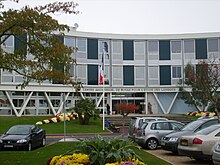Royan
Royan (French pronunciation: [ʁwajɑ̃]; locally [ʁwejɑ̃] in the Saintongeais dialect; Occitan: Roian) is a commune and town in the south-west of France, in the department of Charente-Maritime in the Nouvelle-Aquitaine region.
[3] Capital of the Côte de Beauté, Royan is one of the main French Atlantic coastal resort towns, and has five beaches, a marina for over 1,000 boats, and an active fishing port.
During the Reformation the city became a Protestant stronghold, and was besieged and destroyed by King Louis XIII of France (ruled 1610–43).
The town of Royan is built on a calcareous rock plateau dating from the Cretaceous Period (c. 150 million years ago).
The estuary, the cliffs and the conches were shaped approximately 66 million years ago by the folding of limestone layers as the Alps and the Pyrenees formed.
Between Royan and the town of Saintes, the historic capital of Saintonge and an important centre of art and history, travel time on the RN 150 is just under half an hour.
Royan SNCF railway station is the terminus of a line connecting the town to Saintes, Angoulême, and Niort (for the high-speed TGV rail link to Bordeaux and Paris).
30 km (19 mi) away, Rochefort-Saint-Agnant Airport offers flights to several European destinations, including the British Isles.
A ferry provides bicycle, car and lorry transport across the Gironde estuary to Le Verdon-sur-Mer in the Médoc region.
Harbour activity was significant by the end of the 11th century, and many vessels used the Gironde estuary as a stopping point while waiting for favourable winds or currents.
In 1355, during the Hundred Years' War, the Black Prince, heir to the throne of England, occupied Saintonge and further strengthened Royan's defences.
On 22 December 1789, the National Constituent Assembly set up in the early stages of the French Revolution voted for the administrative division of France into departments in place of the former provinces.
Royan elected a city council at that time, chaired by Daniel Renaud, a Protestant, and mayor Nicolas-Thérese Vallet of Salignac.
On July 12, 1790, the National Constituent Assembly passed a law, the Civil Constitution of the Clergy, which subordinated the Catholic Church to the government.
At the end of November 1790, mayor Nicolas-Thérese Vallet of Salignac was removed from office and was replaced by François d' Aulnis de Puiraveaux.
In general terms, however, the Reign of Terror (la Terreur) after the creation of the First French Republic had little impact in the area, and few of the local nobles were affected.
The town welcomed many prominent guests such as Sacha Guitry, Yvonne Printemps, Mary Marquet, Jacques-Henri Lartigue or the painter Pablo Picasso.
The raid was ordered by Supreme Headquarters Allied Expeditionary Force (SHAEF),[10] which had been told that the only people left in Royan were Germans and collaborators.
[11] The Allied operation against the German forces on the island of Oléron and at the mouth of the Gironde estuary began with a general naval bombardment on 15 April 1945, some 10 months after D-Day.
American B-17 Flying Fortress and B-24 Liberator aircraft carried out aerial bombing missions, including extensive and pioneering use of napalm, finishing the destruction of 5 January.
Howard Zinn, author of A People's History of the United States, was one of many bombardiers who participated in the World War II attacks on Royan.
After the war a new church was built, bigger, architecturally ambitious and spectacular, and drawing its aesthetic inspiration from the large Gothic cathedrals.
Notre-Dame de Royan, completed in 1958 and built entirely of reinforced concrete by architects Guillaume Gillet and Marc Hébrard and engineers Bernard Lafaille, René Sarger and Ou Tseng, is considered a masterpiece of contemporary architecture.
The building's structure alternates prestressed V-shaped reinforced concrete elements made using the Lafaille process, named for its inventor, French engineer Bernard Lafaille, with huge windows, made by master glazier Henri Martin-Granel and covering a total area of 500 square metres (5,400 sq ft).
Its design is based on cubic geometry, relieved by the oblique lines of external staircases and by the subtle interweaving of convex inner walls.
A glass wall opens a broad outlook onto the Gironde estuary, and the building was later extended with gardens under a transparent cube.
Built in 1955 by architects Louis Simon and Andre Morisseau and engineer René Sarger, the Marché central de Royan [fr] is a round concrete shell with walls 8 centimetres (3 in) thick.
It served as the model for the market in Nanterre and for the Centre of New Industries and Technologies (CNIT) in the La Défense neighbourhood of Paris.
Its facilities include twenty soundproof audiovisual rooms, four language laboratories, an auditorium, a library, a television studio and a self-service cafeteria.
Royan has numerous other sports facilities, including two swimming pools, of which one, at Foncillon, is an outdoor seawater pool open in the summer months; several gymnasiums; a sports hall; several tennis courts; a Basque pelota wall; a rugby ground; and a golf course.

